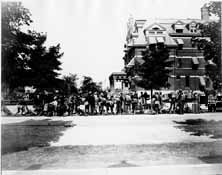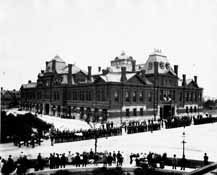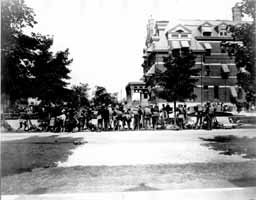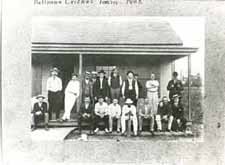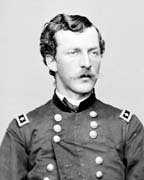Labor and Race Relations
You are at Home -> Labor and Race Relations -> Labor Strife and the Strike of 1894The Great 1894 Strike
Pullman publicized his company town as a model community filled with contented, well-paid workers. The Pullman workers, however disagreed, especially after the onset of the economic depression that begain in 1893. During that depression, Pullman sought to preserve profits by lowering labor costs. When the firm slashed its work force from 5,500 to 3,300 and cut wages by an average of 25 percent, the Pullman workers struck. The American Railway Union (ARU), led by Eugene Debs, was trying to organize rail workers all across the country. The Pullman workers joined the ARU, and Debs became the leader of the Pullman strike. On Friday, May 11th, 1894, at 9:00 a.m. Pullman workers orderly "walked out" of Pullman, with the American Railway Union and its President Eugene V. Debs fully behind them. What followed was the greatest strike in American history. Meetings were held and strike committees formed to arbitrate the situation. ARU delegates decided to boycott Pullman cars on June 26th and the boycott spread throughout the nation. President Grover Cleveland called federal troops in to restore order and placed Debs under arrest. No violence occurred until Independence Day when mobs gathered and burned hundreds of cars. Railroad property damage was estimated at $340,000 and more than forty died in nationwide clashes. Chicago newspaper headlines read, "Big Riot in the Yards" and "World's Fair in Flames." Rioting was not under control until July 18 when workers began returning to Pullman.THE PULLMAN HISTORY SITE

Other Pullman-Related Sites
- Historic Pullman Garden Club - An all-volunteer group that are the current stewards of many of the public green spaces in Pullman. (http://www.hpgc.org/
- Historic Pullman Foundation - The HPF is a non-profit organization whose mission is to "facilitate the preservation and restoration of original structures within the Town of Pullman and to promote public awareness of the significance of Pullman as one of the nation's first planned industrial communities, now a designated City of Chicago, State of Illinois and National landmark district." (http://www.pullmanil.org/)
- The National A. Philip Randolph Pullman Porter Museum is a 501(c)3 cultural institution. Its purpose is to honor, preserving present and interpreting the legacy of A. Philip Randolph, Pullman Porters, the Brotherhood of Sleeping Car Porters and the contributions made by African-Americans to America's labor movement. ((http://www.nationalpullmanportermuseum.com/)
- Pullman Civic Organization - The PCO is a strong and vibrant Community Organization that has been in existence since 1960. (http://www.pullmancivic.org/)
- Pullman National Monument - The official page of the Pullman National Park. (https://www.nps.gov/pull/)
- South Suburban Genealogical & Historical Society - SSG&HS holds the Pullman Collection, consisting of personnel records from Pullman Car Works circa 1900-1949. There are approximately 200,000 individuals represented in the collection. (https://ssghs.org/)
- The Industrial Heritage Archives of Chicago's Calumet Region is an online museum of images that commemorates and celebrates the historic industries and workers of the region, made possible by a Library Services and Technology Act grant administered by the Illinois State Library. (http://www.pullman-museum.org/ihaccr/)
- Illinois Digital Archives (IDA) is a repository for the digital collections libraries and cultural institutions in the State of Illinois and the hosting service for the online images on this site. (http://www.idaillinois.org/)
